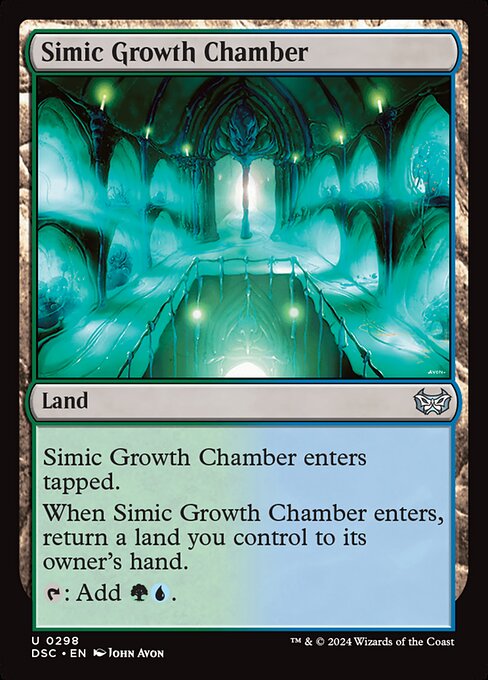
Image courtesy of Scryfall.com
Evaluating a Mulligan with Simic Growth Chamber
If you’re brewing a green-blue (Simic) strategy in Commander, you’ll likely lean into lands, ramp, and a touch of clever mana engineering. Simic Growth Chamber is a curious creature of habit: a land that enters tapped, then pokes you in the tempo with a built-in bounce, and finally untaps into a reliable mana source of G and U when you tap it. The card’s humble entry on the battlefield can feel like a misstep at first glance, but the real value appears as you sequence turns and leverage the bounce to set up stronger plays. 🧙🔥 The trick is recognizing when Mulligans tilt toward long-game value rather than immediate board presence, especially in a format where five-color mana bases and legendary commanders stretch every decision. 💎
“Sometimes you trim a card or two, and the land does the heavy lifting later.”
Why this matters on the opening draw
Growth Chamber is a land with a built-in cost: it enters tapped and, as soon as it does, you have to return a land you control to its owner's hand. That means your first few turns might feel slower than casting a two-drop or a signet, especially if your hand lacks mana fixing or multi-use lands. On the other hand, the ability to tap for G and U later in the same turn or on a subsequent turn can unlock powerful two-color lines for a commander-heavy strategy. When you mulligan, you’re weighing the immediate pressure to stabilize against the long-game tempo this bounce-and-tap combination enables. 🧭 If your opening hand is light on green or blue mana sources, or if you don’t have a solid plan to fix or accelerate, a mulligan toward a hand with more reliable ramp and at least one color fixer tends to pay dividends.
Early-game considerations: pacing your mulligan
In the 60-card world of Commander, aim for hands that enable turn-2 or turn-3 plays. Growth Chamber can be a cornerstone piece of a Stabilize-and-Win plan, but not if you’re staring down an empty board and a tapped land. If your opening grip contains multiple basic lands but few nonland accelerants, you might be better off keeping a hand with a cheap removal spell or a mana-rock that helps you reach G and U by the time you need them. The bounce effect is most valuable when you have a way to recast or reuse lands in subsequent turns—think fetch lands, extra land drops, or effects that reward playing additional lands. The synergy is real: you can bounce a land back to your hand and still have a usable color pair from Growth Chamber, setting up a cleaner two-color line for your next spell. 🎲
Sequencing and practical play patterns
When Growth Chamber enters, you’ll likely want to follow a conservative plan: preserve your options, but avoid overreacting to the temporary tempo hit. A typical sequence might be: play a land, drop Growth Chamber (enters tapped and triggers its ETB bounce), use a second land drop to play another land, and then tap Growth Chamber to generate G and U for a spell you’re already eyeing or a mana-producing play later in the turn. If you’re running other bounce lands, or a Simic ramp package that rewards replaying lands, this is where the chamber shines—each bounce becomes a small investment that pays off as you stack mana sources across turns. The real delight is when you curve into a mana-hungry spell or a greening counter that benefits from both colors. ⚔️
Deckbuilding notes: maximizing value
- Include mana sources that support two-color fixes, such as duals, fetches, or mana rocks that help you reach GU quickly.
- Pair Growth Chamber with other bounce or land-replay effects to turn a tap-then-bounce into a recurring ramp engine.
- Choose creatures and spells that capitalize on having both green and blue mana online by turn three or four.
- Consider commanders and themes that value card draw, counterplay, or incremental advantage to ride the slower ramp into late-game inevitability.
- Be mindful of the set legality and format: Duskmourn: House of Horror Commander is a Commander-level set, and Growth Chamber appears in an uncommon slot with a historically solid EDH footprint.
For fans of the lore and the art, Growth Chamber’s John Avon rendition brings a sense of mystery to the battlefield—an inviting green-blue sheen that whispers of hidden lagoons, tangled mangroves, and the quiet power of growth. In EDH, this is the kind of land you keep tucked in a deck that values inevitability, not just speed. And as with most Simic tools, the real thrill is how you chain tiny advantages into big turns. 🧙🔥
Pro tip: if you’re running a toolkit-y list with card draw, bounce echoes, and protective counterplay, Growth Chamber doubles as a mana source and a tempo engine. You don’t just play a land—you create ley lines of opportunity that become increasingly valuable as the game evolves. The card’s graceful design—zero mana cost to cast, extra color options, and a clever ETB trigger—embodies the spirit of Simic: adaptable, resilient, and always a touch unpredictable. 🎨
As you mulligan more and more with this card in mind, you’ll learn to read your opening hand like a well-worn playmat. If you spot a path to early pressure with a safe fallback, keep it. If not, send it back and chase the hands that promise smoother ramp and timely fixes. Your future self (and your playgroup) will thank you when Growth Chamber starts delivering two colors on demand with a bounce in your back pocket. 🧙⚔️
Non-slip Gaming Mouse Pad with Polyester Surface
More from our network
- https://crypto-acolytes.xyz/blog/post/reddened-color-index-signals-hot-giant-at-4-kpc/
- https://transparent-paper.shop/blog/post/strategic-brand-positioning-for-competitive-markets/
- https://transparent-paper.shop/blog/post/create-effective-banner-templates-for-small-businesses/
- https://blog.digital-vault.xyz/blog/post/the-best-wireframing-and-prototyping-tools-for-ux-designers/
- https://transparent-paper.shop/blog/post/monochrome-digital-paper-for-minimalist-brand-identity/